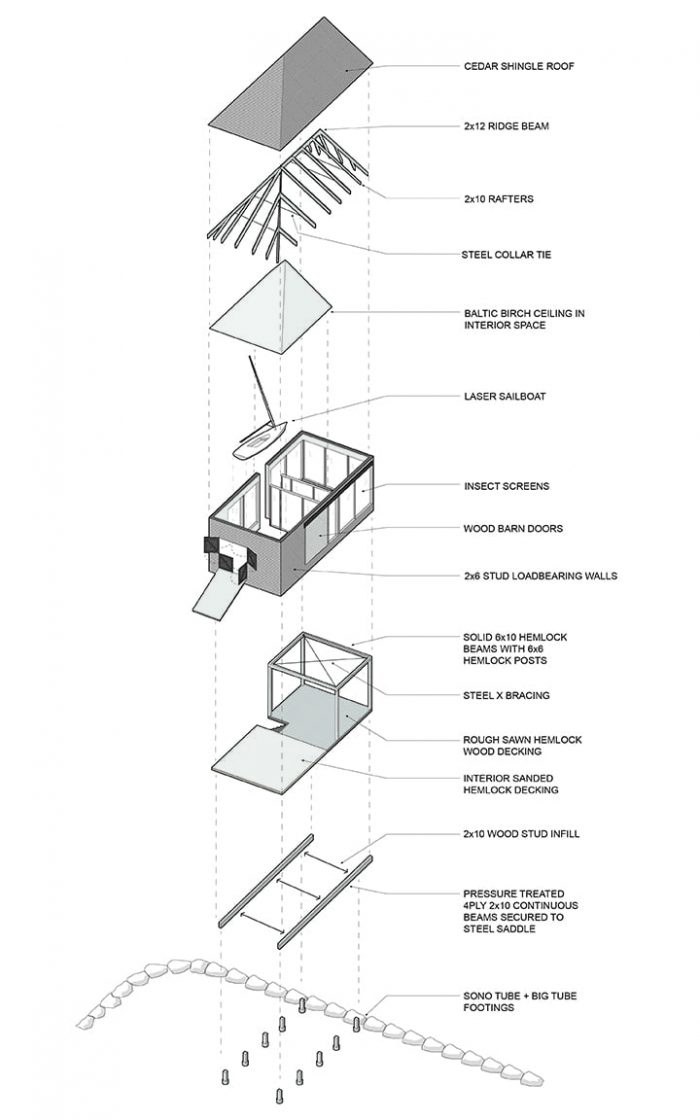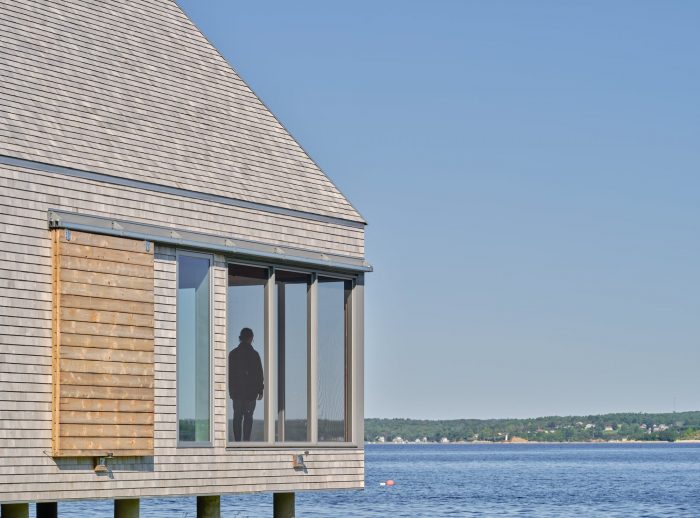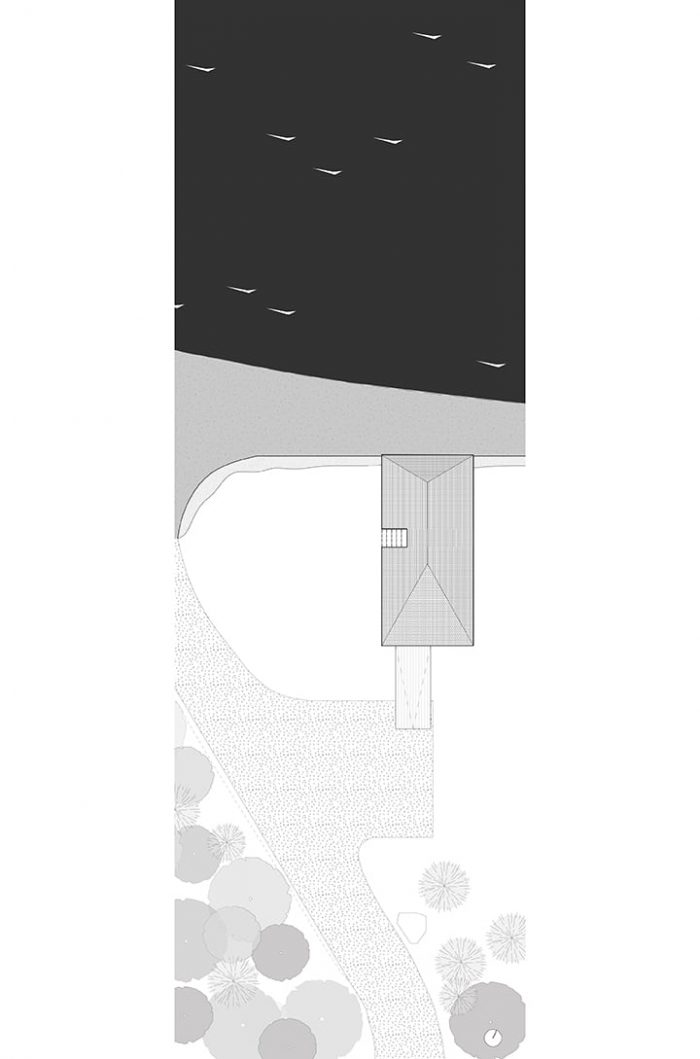这个地方位于新斯科舍省南岸的赫尔曼岛,沿着一段偏远的海岸线,背对新斯科舍省的马洪湾。在这个偏远的地方,沿着这块地的朝西的森林海滩边缘,他们想创造一个既能储存船只的功能空间,又能与水和西部的日落联系起来的休闲、禅意的地方。规划限制将海边的开发只限于船屋。这一限制在设计中被接受,作为一种重新加强结构和选址的元素、海洋性质的方式。
This site is located on Herman’s Island, on the South Shore of Nova Scotia along a section of remote, shoreline facing back into Mahone Bay, Nova Scotia. At this remote location, along the forested west-facing beach edge of the lot they wanted to create both a functional space for boat storage and a leisurely, Zen place for connecting to the water, and the western sunsets. Planning restrictions limit ocean-side development to boathouses only. This restriction was embraced in the design, as a way of re-enforcing the elemental, maritime nature of the structure and the siting.
这个地方很偏僻,从岛上传统的定居的南部海岸线到北部更荒凉的森林,有一条私人车道可以进入。在这种情况下,与新斯科舍船屋的既定理念及其特定的、强大的形式脉络存在着一定程度的关键错位。从隐喻的角度来说,穿越森林的西行之路成为一个通道,从卢嫩堡县根深蒂固的建筑乡土中走出来,来到一个更原始的环境中,在那里,既有的形式意象可以被扭曲和重新想象。
The location is remote, accessed via a private drive running back from the island’s traditionally settled south coastline to the more wild, forested north. In this context, there is a degree of critical dislocation from the established idea of Nova Scotian Boathouse, and its particular, strong formal lineage. Metaphorically, the journey west through the forest becomes a passage out of the deeply rooted architectural vernacular of Lunenburg County to a more primordial context where established formal imagery can be warped and re-imagined.
这样一来,船屋的设计就成了一个表现性的重新诠释和实验的点。 屋顶的坡度是不同的,西边的臀部更强烈地向海倾斜,而东边的坡道入口处则保持了人的尺度。坡道本身背对着陆地,颠覆了通常面向海洋的方向。室内装饰被俏皮地重新解释,功能也偶尔被颠倒。
In this way, the Boathouse design became a point of expressive re-interpretation and experimentation: Roof pitches are varied, with the west hip leaning more strongly out to sea, while the east maintains a human scale at the ramp entry. The ramp itself, in facing back to the land, inverts the usual ocean-facing orientation. Interior finishes are playfully re-interpreted, and functions are occasionally inverted.
立面被允许对场地条件做出反应:北侧的开口最小,南侧的开口最大,以利用阳光。南面立面的深切面对比并强调了体量,同时接纳了一个隐蔽的楼梯进入平面中间,将两个功能区分隔开。建筑设置在悬停在高水位线之上的高跷上,前门廊悬空在海滩边缘。观景门廊朝向水面,后面是船库。
The elevations are allowed to respond to site conditions: minimal openings on the north side, maximum openings on the south side to take advantage of sun. A deep cut in the south elevation contrasts and emphasizes the mass of the volume, while admitting a concealed stair up into the middle of the plan which bisects the two functional zones. The building is set on stilts hovering above the high-water line, with the front porch cantilevering over the beach edge. The viewing porch faces out to the water, with boat storage behind.
这两个船库的功能决定了在木材类型、饰面和支撑方面有两种不同的设计和结构策略。门廊屏风区的墙壁和地板要暴露在天气和海洋风暴中,需要一种能在盐碱环境中保存下来的抗腐木种。因此,前廊区域的设计采用实心铁杉木和横梁,实心粗锯铁杉木装饰板,外露钢制横撑,没有层压木制品。天花板是暴露的结构,有暴露的拉杆。内部的船库是2 x 6的木墙骨结构,不会暴露在天气中,并提供胶合板单板包覆的天花板和墙面,铺设磨光铁杉木地板。
The two boathouse functions dictated two different design and structural strategies in terms of wood types, finishes, and bracing. The porch screened area walls and floors are to be exposed to the weather and ocean storms and require a rot-resistant wood species that can be preserved through the saline environment. As such the front porch area is designed with solid hemlock timber and beams, solid rough sawn hemlock decking with exposed steel cross bracing, and no laminated wood products. The ceiling is exposed structure with exposed tie rods. The interior boat storage area is a 2 x 6 wood stud construction that will not be exposed to the weather, and is provided with a plywood veneer clad ceiling and walls with a sanded hemlock wood flooring.
外部材料直接参考了周围的森林环境:未经处理的东部雪松木瓦,云杉框架和当地粗锯铁杉。这个项目在2022年赢得了新斯科舍省副省长的优秀奖章–建筑业的最高奖项。
The exterior materials refer directly to the surrounding wooded context: untreated eastern cedar shingles, spruce framing and local rough sawn hemlock. This project won the Nova Scotia Lieutenant Governor’s Medal of Excellence- the highest award for architecture – in 2022.
Architects: Abbott Brown Architects
Area : 520 ft²
Year : 2021
Photographs :Julian Parkinson
Manufacturers : Marvin
Lead Architects : Jane Abbott, Kim Chayer
Structural Engineering : Andrea Doncaster Engineering Limited
General Contractor : Risser Design Build
City : Hermans Island




















